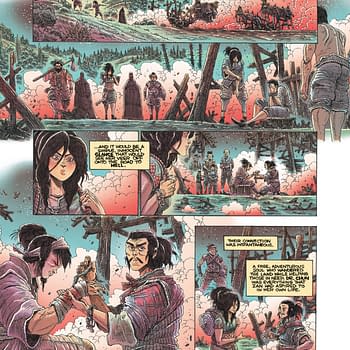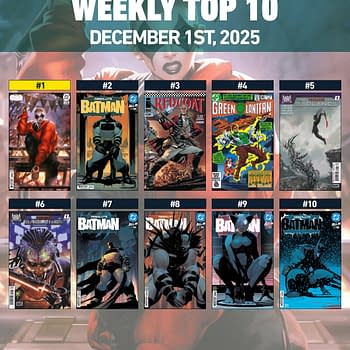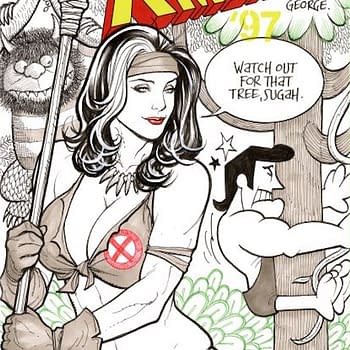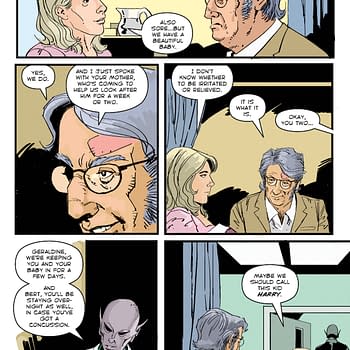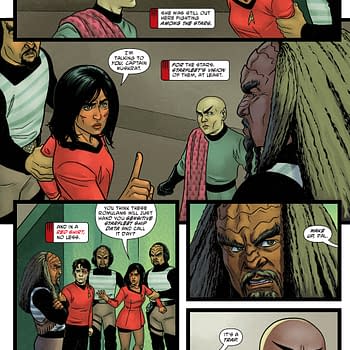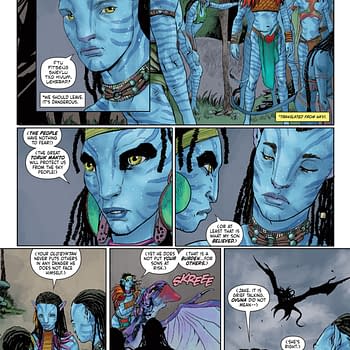Posted in: Comics | Tagged: Benjamin Percy, Black Box, Comics, dynamite, entertainment, HRL, james bond
Writer's Commentary: Benjamin Percy Talks James Bond #4 And A Proper Car Chase
Straight from Dynamite, here's a writer's commentary from Benjamin Percy talking about James Bond #4. Cover art by Dominic Reardon with interiors by Rapha Lobosco.
PAGE 1:
Fleming refers to Bond as a blunt instrument; a weapon. So I liked the idea of creating parallelism between his eye and the muzzle of a gun, as they can be considered one and the same.
I love what Rapha does here with shadows. Making them bold and heavy, offsetting the neon-lit Tokyo cityscape.
PAGE 2-5:
I've mentioned my checklist in previous commentaries and interviews. Readers have certain expectations when reading or watching a Bond story. A proper car chase that showcases a few gadgets and takes advantage of its surroundings (whether a curvy mountain road or a series of narrow alleyways) is one of them.
And a proper car chase isn't over in three or four pages. It needs space to breathe (or, rather, space enough to make the reader lose their breath).
PAGE 6-7:
Here's a lovely, heart-pounding, knuckle-whitening spread by Rapha with some distinctive coloring from Chris (I like to think of it as noir-arcade).
When I first started working in comics, I cramped too many panels on to too few pages — and I've since learned the importance of visually telegraphing the emotional or physical resonance of a scene. I try to allow myself room for several splashes and a few spreads in every issue, timed accordingly. These, simply put, are the "holy shit" moments.
PAGE 8-9:
When I was a grad student, my professor said to me, "You shouldn't write car chases into novels. They're better left for film."
He was referring to a scene in my manuscript, which likely wasn't very good — but still, a sweeping proclamation like that annoyed me. I was thinking of him when I wrote The Dark Net (my latest novel, which features a doozy of a car chase). And I was thinking of him here as well.
Comics are their own medium. But after writing a car chase into a novel, I loved being able to borrow more heavily from the sensory techniques of film. Zooming in and out, going high or low with the perspective. Slowing down and speeding up time.
In an early draft, I included some narration as well, allowing access to Bond's mind to feed us some exposition — but I ultimately trashed that because the captions gummed things up, slowed things down. And when you're writing a car chase, you want speed. Adrenaline. Reflex. Instinct. The deep thoughts can come later, in a moment of repose.
PAGE 10-11:
Whenever you have oversized, fantastical scenes (such as a rubber-burning car chase), it's important to anchor them in reality. Add in the ordinary to balance out the extraordinary.
That's why the octopus (from the street vendor) splats his windshield. And that's why we include the people from the market in the action scene. It normalizes the high-wire action and makes it feel like the physics and stakes of our world might actually apply.
PAGE 12-13:
The last page ends with a reversal: Selah Sax suddenly barging into view, taking down the baddies with her bumper. She kicks open the door to her car and waves Bond inside. I've mentioned before her importance to me in the story. Making her a badass, someone who can outwit and outgun Bond. He'll get his chance to return the favor later, but for now, she's a stunning friend, colleague, and adversary.
I love the SFX on this page. It's so over-the-top — but that suits the larger-than-life 007. If he's going to go down, if he's going to get shot in the back, a bombastic character requires a bombastic takedown.
And Rapha erased Bond face of everything except his gritted teeth, which makes the moment that much more impactful, as he's nothing but shredded nerve endings, blackening pain.
PAGES 14-15:
Stories are made up of peaks and valleys. We've just ripped our way through a 13-page action sequence. It's time to slow things down…
…and get it on.
For the best effect, these two pages should be accompanied by a Barry White soundtrack.
PAGES 16-17:
And here's where we at last get the dark, complicated backstory on Selah Sax.
Suspense is all about withholding information, doling it out as needed. This reveal is something I've been teasing from the first issue. Her motivation. It turns out to be altruistic — but puts her on a collision course with Bond. She has gone rogue and he serves his country.
Rather than an exposition dump — during which Selah simply unloaded her history — we made this more impressionistic. They're having sex, so they're vulnerable, entwined. When Bond shares (via narration) her story, there's the physical and emotional implication of secret-sharing. And the steam from the shower contributes to the dream-like haze of recollection.
PAGES 18-19:
A check in with M and Q is necessarily transitional — in that it reminds us of the larger stakes of the story. The secrets of the UK government and military are at stake. Saga Genji has harvested vulnerable data through his malware and he's ready to unleash it as a weapon.
But now the stakes have raised. The UK isn't the only one impacted, we learn. Countries around the world have been breached as well. That explains Felix's shady appearance earlier.
And now the mission changes. We've reached a fulcrum point in the story, a moral quandary. Bond is no longer directed to destroy the black box of information. He now must secure it. Bring it back to England. In doing so, he would weaponize the British with the world's dirty laundry.
And this is something Selah — who has her own terrible history, her own dark secrets — would completely oppose.
PAGES 20-21:
Years ago, I read a piece in the New Yorker by Larissa MacFarquhar about the Suicide Forest of Japan. In the woods of Adkigahara, in the shadow of Mt. Fuji, dozens of people kill themselves every year. It's a beautiful, sad, deeply disturbing article — and I knew I had to find a way to work it into a story. So this is the backdrop for our cliffhanger — and for the action set-piece that will open up the next issue.
PAGE 22:
This page was inspired by John Carpenter's Halloween. The moment when Jamie Lee Curtis backs up against the shadows and the pale face of Michael Meyers slowly emerges, like a moon coming out from behind the clouds.















